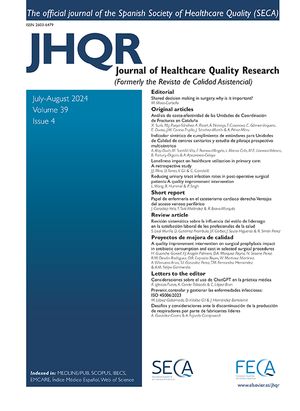El tratamiento del dolor postoperatorio mediante el diseño de una vía clínica constituye una oportunidad de mejora, que facilitará la toma de decisiones al clínico, unificando las pautas de tratamiento, y mejorando la definición de funciones, para dar una mayor calidad asistencial.
MetodologíaEl diseño de la vía clínica del dolor postoperatorio fue realizado entre los servicios de anestesiología, medicina preventiva y la unidad de calidad, implicando al personal médico y al de enfermería. Se adaptó la mejor evidencia técnica posible a las características de los pacientes del centro y a las preferencias de los profesionales.
ResultadosLa vía clínica de dolor postoperatorio está enfocada a los pacientes con criterios de dolor moderado-intenso y consta de tres fases: la inicial, en la unidad de reanimación postanestésica (URPA) que abarca desde el ingreso hasta la segunda hora; la fase de estabilización, ya en planta, a partir de la segunda hora hasta las 12 h, y la fase de finalización, el segundo día en planta.
Cuenta con el documento de la matriz, un recordatorio de las acciones, tratamientos, objetivos y criterios de actuación; las órdenes de tratamiento, un documento operativo de registro y evaluación, y los indicadores de evaluación.
ConclusionesEl diseño de una vía clínica del dolor postoperatorio permitirá la coordinación entre anestesia y cirugía en la atención del paciente postoperatorio desde reanimación hasta la planta de hospitalización.
La vía clínica del dolor postoperatorio constituye el núcleo fundamental del programa de dolor agudo postoperatorio instaurado en el Hospital Universitario La Paz, que permitirá dar una atención más acorde con las necesidades del paciente postintervenido.
The treatment of postoperative pain through the design of a clinical pathway constitutes an opportunity for quality improvement. The clinical pathway for postoperative pain will help practitioners to make decisions about patient management by standardizing activities and treatments and improving role definition and will increase healthcare quality.
MethodologyA clinical pathway for postoperative pain was designed jointly by the Departments of Anesthesia and Preventive Medicine and the Quality Unit. Medical and nursing professionals were involved. The best possible technical evidence was adapted to the patient characteristics of the center and to the preferences of healthcare professionals.
ResultsThe clinical pathway for postoperative pain focusses on patients with criteria of moderate-to-severe pain and consists of three phases: the initial phase, in the Recovery Unit, lasts from admission to the second hour after surgery, the stabilization phase, in the surgical ward, lasts from the second to the twelfth hour after surgery, and the conclusion phase lasts from the second day in the ward.
The clinical pathway documents comprise the clinical pathway card, which contains the sequences and times of interventions, treatments, objectives and criteria for interventions; the treatment orders, an operating document for record keeping and evaluation and finally the evaluation indicators.
ConclusionsThe design of the clinical pathway for the management of patients with postoperative pain will improve coordination between the Departments of Anesthesia and Surgery in postoperative patient care from the recovery room to the surgical ward.
The clinical pathway for postoperative pain constitutes the basis for the Acute Postoperative Pain Program established at the University Hospital of La Paz, which will help to adjust healthcare more closely to patients’ postoperative needs.






